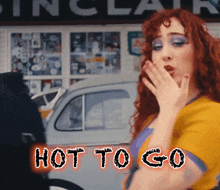In the ever-shifting terrain of beauty standards, one unsettling constant remains: the unrelenting message that "You will never be pretty enough." This article embarks on a chronological journey through time, exploring the beauty ideals and societal pressures that have weighed heavily on women over a century. Through the lens of historical context and the voices of women who lived through each era, we'll delve into the unending quest for beauty and how it has impacted women's self-esteem and self-worth.
Let us slide into your dms 🥰
Get notified of top trending articles like this one every week! (we won't spam you)The Victorian Era: A Delicate Ideal
The 19th century, the Victorian era, was characterized by rigid societal norms and particularly stringent beauty standards for women. The epitome of beauty during this period was a delicate and pale appearance, achieved through restrictive corsets and the avoidance of sun exposure. As suffragist and writer Charlotte Perkins Gilman once wisely noted, "The beauty of a woman is not in a facial mode, but the true beauty in a woman is reflected in her soul." Despite these ideals, women were already grappling with societal expectations and beauty norms.
The Victorian era, spanning from the early 19th century to the beginning of the 20th century, was a time characterized by rigid societal norms and particularly stringent beauty standards for women. This period, named after Queen Victoria of England, was marked by a sense of modesty, decorum, and an emphasis on femininity.
One of the prevailing beauty ideals of the Victorian era was a delicate and pale appearance. To achieve this, women went to great lengths, literally, by tightly lacing themselves into corsets. These corsets, made of various materials like whalebone, steel, and fabric, were designed to cinch the waist to an extreme degree.
The result was the coveted hourglass figure that was highly prized during this time. The corset also enhanced the fragility and delicacy that were considered desirable qualities in a woman.
The Victorian era's beauty standards were not only physically demanding but also deeply entrenched in the moral values of the time. A virtuous woman was expected to be modest and chaste, and her beauty was seen as an outward manifestation of her inner purity. Therefore, maintaining an appearance of delicate vulnerability was essential for social acceptance.
Despite these rigid beauty ideals, some women challenged the status quo. Pioneering women like Amelia Bloomer, who advocated for less restrictive clothing for women, or the famed suffragist and writer Charlotte Perkins Gilman, pushed back against the notion that a woman's worth was solely tied to her appearance. As Gilman wisely noted, "The beauty of a woman is not in a facial mode, but the true beauty in a woman is reflected in her soul." These women laid the foundation for the gradual transformation of beauty standards as the 20th century approached.
Take the Quiz: Which Rapper Are You Most Like?
Take this quiz to find out which rapper you're like the most!
The Roaring Twenties: The Flapper Rebellion
The 1920s brought about a drastic shift in beauty ideals. Women embraced a more rebellious, independent spirit during the "flapper" era, characterized by short hair, minimal makeup, and an unapologetic attitude. Author F. Scott Fitzgerald's character Daisy Buchanan in "The Great Gatsby" famously mused, "I hope she'll be a fool—that's the best thing a girl can be in this world, a beautiful little fool." The '20s was a time of challenging traditional beauty standards, yet it introduced its own set of expectations.
Beyond their appearance, flappers defied conventions through their behavior and attitudes. They openly smoked, drank, and danced in public, activities that were considered scandalous for women at the time. They also rejected traditional notions of courtship and marriage, advocating for greater personal freedom and independence.
Author F. Scott Fitzgerald captured the spirit of the era in his novel "The Great Gatsby" through the character of Daisy Buchanan, who famously stated, "I hope she'll be a fool—that's the best thing a girl can be in this world, a beautiful little fool." This quote reflects the rebellion against traditional roles and expectations.
The flapper movement was a response to the horrors of World War I and the desire to break free from the constraints of the past. These women embraced living in the moment, epitomized by the wild dances of the time, such as the Charleston. Jazz music and speakeasies were at the heart of the flapper culture, providing a space for socializing, dancing, and expression.
The 1950s: The Hourglass Figure and Domesticity
The 1950s marked the return to a more conservative yet curvaceous ideal. The hourglass figure, exemplified by iconic actress Marilyn Monroe, became the ultimate symbol of beauty. As Marilyn Monroe once declared, "Imperfection is beauty, madness is genius, and it's better to be absolutely ridiculous than absolutely boring." Behind the glamorous facade, however, women were still primarily confined to domestic roles and stifled by societal expectations.
However, this beauty standard came with its expectations and limitations. Women were expected to be glamorous and well-groomed at all times. They spent significant time and effort on their appearance, from setting their hair in rollers to meticulously applying makeup. The pressure to maintain this image could be overwhelming, and the effort put into achieving the idealized hourglass figure often concealed the reality of women's lives in the 1950s.
In addition to the beauty standards, the 1950s promoted the idea of domesticity for women. The post-war period encouraged a return to traditional gender roles, where women were expected to focus on homemaking, child-rearing, and supporting their husbands. The ideal woman of the 1950s was portrayed as a homemaker who excelled in cooking, cleaning, and caring for her family. Magazines and advertisements frequently featured images of women in domestic roles, reinforcing the notion that their primary sphere was the home.
While many women embraced this domestic ideal, it was not universally satisfying. Some women felt constrained by these narrow roles and longed for more diverse opportunities beyond homemaking. This tension between societal expectations and personal aspirations marked the 1950s as a time of conformity and burgeoning discontent.
The 1950s represented an era where the hourglass figure and domesticity were paramount in beauty and societal expectations. While it celebrated a particular type of femininity and domestic role for women, it also laid the groundwork for future challenges to these norms.
The 1950s' beauty standards and ideals, with their strengths and limitations, continue to shape our understanding of women's roles and self-image today. It serves as a reminder that beauty ideals are not just about appearance but are deeply intertwined with the societal expectations and limitations placed on women.
The 1980s: Power Dressing and Supermodels
The 1980s saw a new wave of beauty standards emerge. Power dressing, bold makeup, and the rise of supermodels like Cindy Crawford and Naomi Campbell became synonymous with the era. Model Tyra Banks eloquently stated, "Girls of all kinds can be beautiful—from the thin, plus-sized, short, very tall, ebony to porcelain-skinned; the quirky, clumsy, shy, outgoing, and all in between." But even in the '80s, the relentless pursuit of a particular beauty brand persisted.
The 1980s left an enduring legacy in the world of beauty and fashion. Power dressing challenged traditional gender roles, and supermodels brought diversity and charisma to the modeling world.
Both these phenomena helped redefine beauty and representation in the following decades, showcasing that beauty could be a symbol of strength and individuality rather than mere conformity to established standards. The 1980s was a time when women asserted themselves and redefined their place in society, and these changes left an indelible mark on the beauty standards of the time.
The Digital Age: The Influence of Social Media
The 21st century ushered in the era of social media, drastically altering beauty standards. The digital age brought forth an avalanche of edited and retouched images, setting unrealistic expectations for beauty. As actress Emma Watson astutely noted, "I don't want other people to decide who I am. I want to decide that for myself." Despite this desire for self-determination, young women today are constantly bombarded by filtered and manipulated images that perpetuate unattainable beauty ideals.
As we traverse through the beauty standards of different eras, one undeniable truth emerges: the pursuit of beauty has been a relentless journey. The voices and experiences of women from various periods reveal the societal pressures and the ever-changing standards of beauty that have been a constant presence in their lives. While society has progressed, the whisper of "You will never be pretty enough" remains ever-present.
However, there is hope within this narrative. Women's voices, driven by their own unique experiences and a desire for self-acceptance, continue to challenge these standards. Through their efforts, we can hope for a future where beauty is inclusive and not determined by external expectations and where the message "You will never be pretty enough" is replaced by "You are beautiful as you are."














